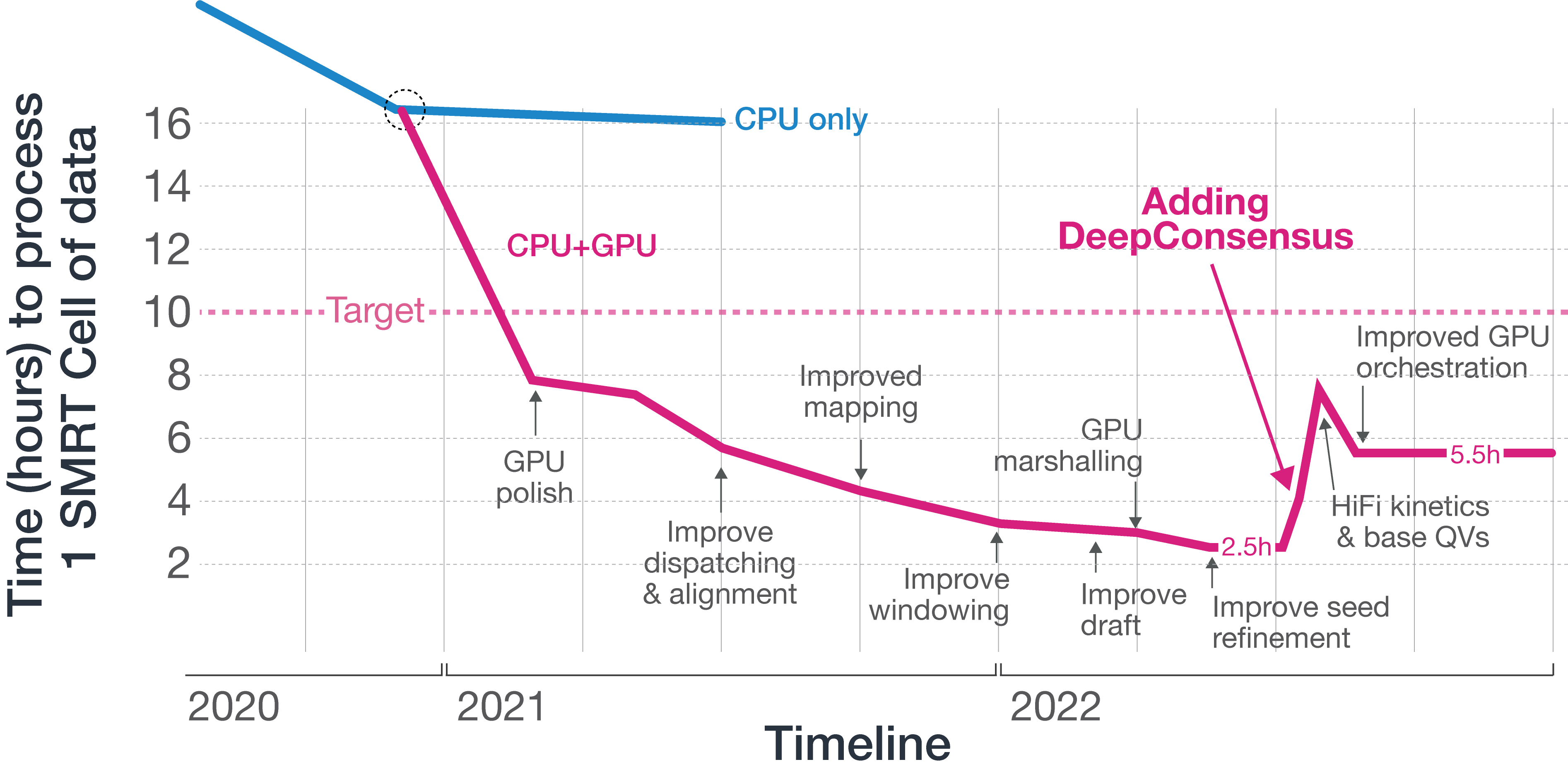Revio FAQ
What ccs differences are between Sequel IIe and Revio?
ccs is always run on the Revio platform. Intermediate CLR BAM files are no longer stored, nor can be transferred, as file sizes exceed one TBytes per SMRT Cell 25M. Aside constant algorithmic improvements, there are few changes since the 6.4.0 SQIIe release.
- Arrow polishing is performed on GPU.
- DeepConsensus further increases accuracy of lower quality windows.
- Performance improvements.
- The customer-facing files layout changed.
- A new
fail_reads.bamhas been introduced.
GPU polishing
 The polish algo in ccs is an HMM, filling out matrices at its core. The nature of its operations makes an efficient GPU implementation challenging. We’ve ported it completely onto Nvidia GPUs and achieved a 10x speedup over a dual 64c AMD EPYC, easily the fastest HMM on GPU.
The polish algo in ccs is an HMM, filling out matrices at its core. The nature of its operations makes an efficient GPU implementation challenging. We’ve ported it completely onto Nvidia GPUs and achieved a 10x speedup over a dual 64c AMD EPYC, easily the fastest HMM on GPU.
DeepConsensus
We have tightly integrate Google’s DeepConsensus into ccs. For this, we have implemented a C++ front-end using ONNXruntime and accelerated it on TensorRT cores of modern data center Nvidia GPU cards. HiFi read generation on the Revio system uses a multi-step process, which also has an impact how the predicted read quality is computed:
- Generate an initial consensus sequence and base quality values using the arrow Hidden Markov Model.
- Pass windows with low quality from the initial consensus to the DeepConsensus deep learning model for further polishing. DeepConsensus refines the sequence and calculates base quality values for the windows it processes. For a typical human WGS run, somewhere between 30-70% of windows in a read are polished with DeepConsensus. The read quality is calculated after this stage as the average of the DeepConsensus (for processed windows) and arrow (for unprocessed windows) base quality values, as DeepConsensus and arrow are calibrated for their respective windows.
- Having final base quality values come from a single model is critical to making them usable by downstream tools, so the refined sequence is processed again with arrow to calculate base quality values for all windows. The arrow model tends to slightly underestimate base quality in windows refined with DeepConsensus, so these final values are not used for calculating rq. For those that observe differences between rq and the mean of base qualities, this step may explain a significant source of those differences.
- Finally, base quality values are binned into 7 quality bins to optimize file size.
Performance
A quick timeline of the improvements that went into the Revio release with SMRT Link v12.0.

Files layout
With the introduction of the Revio platform, the directory structure and files layout changed within each movie directory. We split ccs reads into hifi_reads.bam and fail_reads.bam instead of mixing them into one reads.bam file.
What is inside fail_reads.bam?
This new file contains following reads:
- Polished reads that did not pass the HiFi Q20 threshold.
- Reads that are from the spike-in control sample.
- Single-stranded ccs reads.
- The median full-length subread of each ZMW that could not generate a consensus.
- Reads with adapter concatemers.
- Reads with miscalled adapters.
- Reads with one or more adapters close to either end.